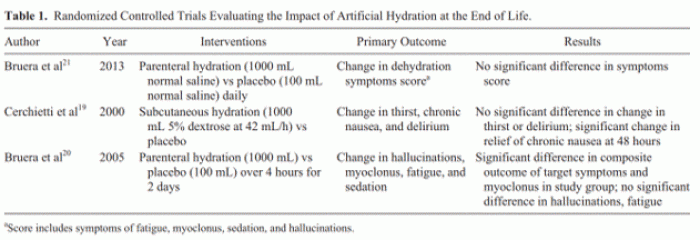Artificial Hydration at End of Life - #77
Take QuizKey points when discussing risks and benefits of artificial hydration in advanced dementia patients and in patients nearing the end of life:
- Observational studies found that patients with abdominal malignancies who received AH at the end of life experienced more peripheral edema, pleural effusions, and ascites (4). Limiting or decreasing the volume of fluid to avoid these adverse outcomes may reduce discomfort.
- No difference was found in the prevalence of agitation or delirium between hydrated and not hydrated groups (4).
- Family members may perceive their loved ones to be suffering at the end of life due to hunger or thirst. Providing AH may provide these families with emotional and psychological benefit (5, 6).
- In chronic illnesses such as advanced dementia, AH will not change the overall trajectory of the disease and may only provide minimal symptom relief.
- Proper oral care, artificial saliva, and careful providing of oral fluid as tolerated should be provided, as these interventions may improve symptoms of thirst and discomfort.
Key questions to ask in decision making:
- What are the views and preferences of the patient and family?
- What are the individualized goals of care?
Patients and family members in the inpatient or outpatient setting.
Provide information and guidance to be used in decision-making for patients and family members regarding hydration in advanced dementia patients or in patients nearing the end of life.
A randomized controlled trial (N=129) of cancer patients nearing the end of life received 1000 mL normal saline over seven days vs 100 mL normal saline. Survival was 21 days versus 15 days respectively (p = 0.83) (7). Although not statistically significant, at the end of life artificial hydration may add an additional six-days of survival time. While artificial hydration does not change the course of disease the family and patient need to determine if this is in line with the patient’s care and life goals.
Dementia is characterized by a progressive, irreversible, and expected cognitive and physical decline. The leading causes of mortality in advanced dementia patients are infection and dysphagia (1). Generally, dysphagia increases slowly over time, however, there may be periods where fluid intake abruptly decreases or stops completely. The onset of abruptly decreased oral intake should cue providers and family to search for reversible causes such as painful swallowing, depression, acute medical illness or delirium. However, in many cases no reversible causes are identified. Family members may inquire about the possibility of artificial hydration. Artificial hydration (AH) is defined as providing liquids through non-oral routes, such as intravenous (IV), subcutaneous (SQ), or enteral or parental nutrition (2, 3). Open discussions with family members and patients regarding the risks and benefits of AH when nearing end of life are essential to patient care.
- Identify key points for discussion of risks and benefits of AH nearing the end of life.
- Improve provider’s comfort level with difficult discussions with patients and family members.
Geriatric Topics
- Mitchell, S. L., Teno, J. M., Kiely, D. K., Shaffer, M. L., Jones, R. N., Prigerson, H. G., Volicer, L., Givens, J. L., and Hamel, M. B. (2009) The clinical course of advanced dementia. New England Journal of Medicine 361, 1529-1538
- Casarett, D., and Kapo, J. (2005) Appropriate use of artificial nutrition and hydration-fundamental principles and recommendations. The New England Journal of Medicine 353, 2607
- Vidal, M., Hui, D., Williams, J., and Bruera, E. (2016) A prospective study of hypodermoclysis performed by caregivers in the home setting. Journal of pain and symptom management 52, 570-574. e579
- Morita, T., Tei, Y., and Inoue, S. (2003) Agitated terminal delirium and association with partial opioid substitution and hydration. Journal of palliative medicine 6, 557-563
- Hui, D., Dev, R., and Bruera, E. (2015) The last days of life: symptom burden and impact on nutrition and hydration in cancer patients. Current opinion in supportive and palliative care 9, 346
- Mercadante, S., Ferrera, P., Girelli, D., and Casuccio, A. (2005) Patients' and relatives' perceptions about intravenous and subcutaneous hydration. Journal of pain and symptom management 30, 354-358
- Bruera, E., Hui, D., Dalal, S., Torres-Vigil, I., Trumble, J., Roosth, J., Krauter, S., Strickland, C., Unger, K., and Palmer, J. L. (2013) Parenteral hydration in patients with advanced cancer: a multicenter, double-blind, placebo-controlled randomized trial. Journal of clinical oncology 31, 111
- Good, P., Cavenagh, J., Mather, M., and Ravenscroft, P. (2008) Medically assisted hydration for adult palliative care patients. Cochrane Database of Systematic Reviews 2
- Bear, A. J., Bukowy, E. A., and Patel, J. J. (2017) Artificial Hydration at the End of Life. Nutrition in Clinical Practice 32, 628-632
